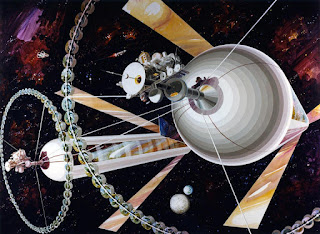In a 1974 Physics Today article, physicist Gerard K. O’Neill laid out his theoretical designs for future space-based colonies that he touted as “far more comfortable, productive and attractive” than most cities on Earth. What started as a joke (O’Neill readily admits) turned into something more serious as his calculations began to make a startling amount of sense.
These O’Neill cylinders, which were subsequently detailed extensively in the physicist’s 1976 book High Frontiers, have captivated scientists and futurists for half a century. In 2019, Jeff Bezos gave an entire presentation divulging his desire to build O’Neill cylinders, and the idea is on full display in shows like Babylon 5, novels like Arthur C. Clark’s Rama, and films like Interstellar.
The basic concept of a O’Neill cylinder is that a spinning tube-like structure simulates gravity via a centripetal force acting on humans living on the cylinder’s inner surface. Although the physics of such a structure checks out, actually building one would likely be the most gargantuan megaproject in human history—but scientists from Rochester University think transforming asteroids into O’Neill cylinders might be the best strategy.
In a study published last year, scientists examined near-Earth asteroids, such as Bennu (the object of the OSIRIS-REx mission), as potential candidates for O’Neill cylinders. Asteroids are particularly attractive candidates because the building materials are already in space (ferrying materials from Earth would likely be prohibitively expensive) and they’d protect a colony from space radiation.
A Bizarre Study Says People Can Live in Asteroids. It's Actually a Brilliant Idea.
These O’Neill cylinders, which were subsequently detailed extensively in the physicist’s 1976 book High Frontiers, have captivated scientists and futurists for half a century. In 2019, Jeff Bezos gave an entire presentation divulging his desire to build O’Neill cylinders, and the idea is on full display in shows like Babylon 5, novels like Arthur C. Clark’s Rama, and films like Interstellar.
The basic concept of a O’Neill cylinder is that a spinning tube-like structure simulates gravity via a centripetal force acting on humans living on the cylinder’s inner surface. Although the physics of such a structure checks out, actually building one would likely be the most gargantuan megaproject in human history—but scientists from Rochester University think transforming asteroids into O’Neill cylinders might be the best strategy.
In a study published last year, scientists examined near-Earth asteroids, such as Bennu (the object of the OSIRIS-REx mission), as potential candidates for O’Neill cylinders. Asteroids are particularly attractive candidates because the building materials are already in space (ferrying materials from Earth would likely be prohibitively expensive) and they’d protect a colony from space radiation.
A Bizarre Study Says People Can Live in Asteroids. It's Actually a Brilliant Idea.




.jpeg)
No comments:
Post a Comment